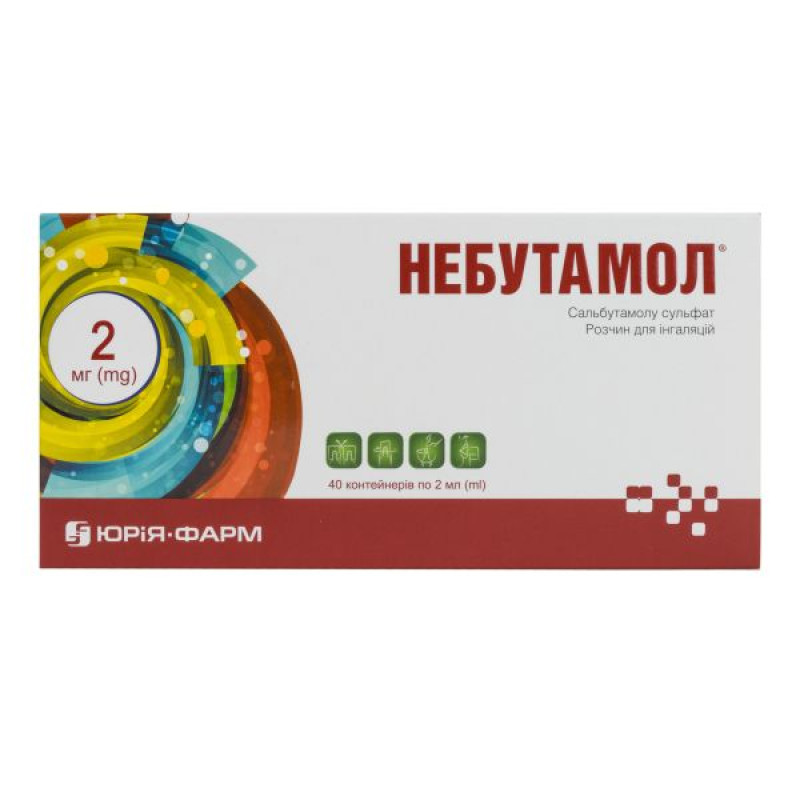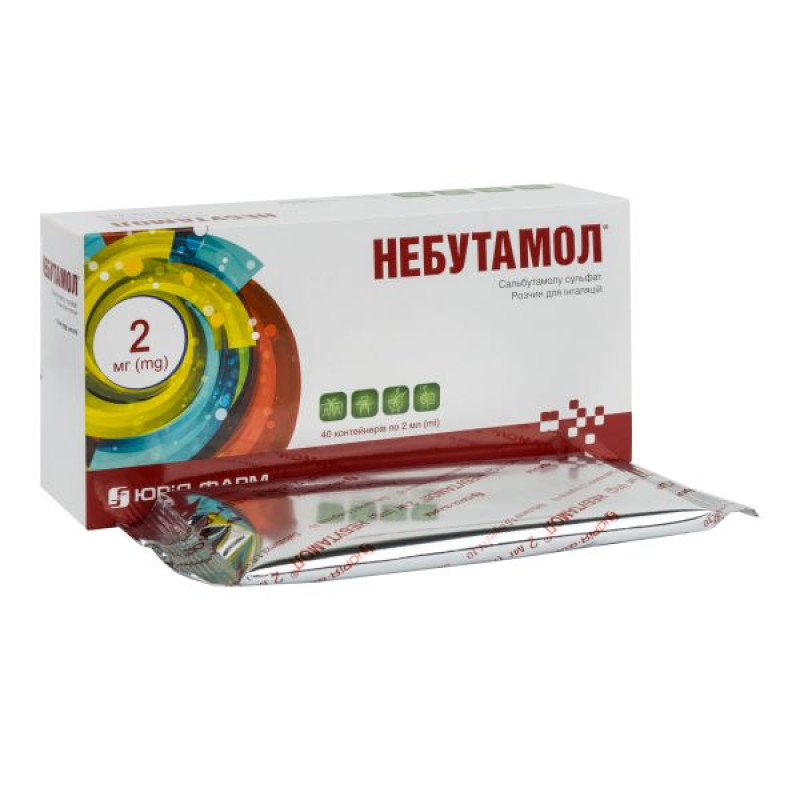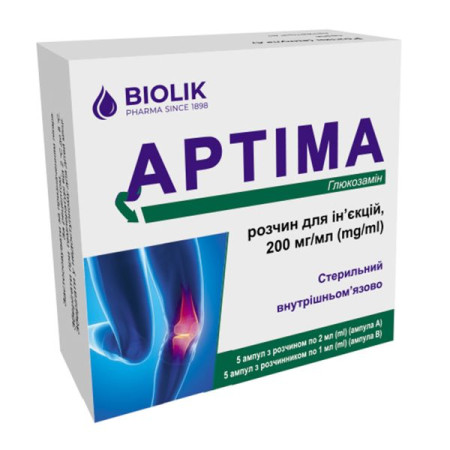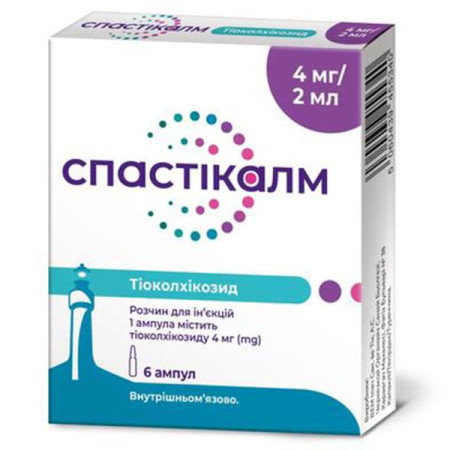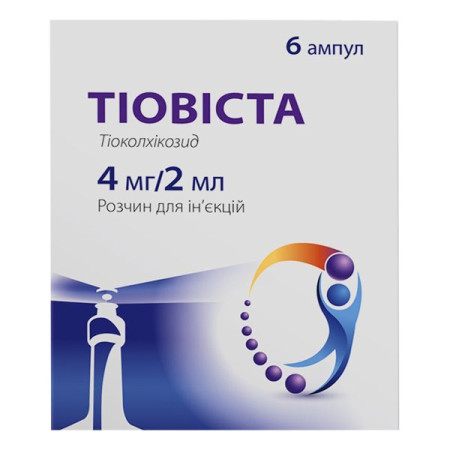Nebutamol inhalation solution 1 mg/ml single-dose container 2 ml No. 40
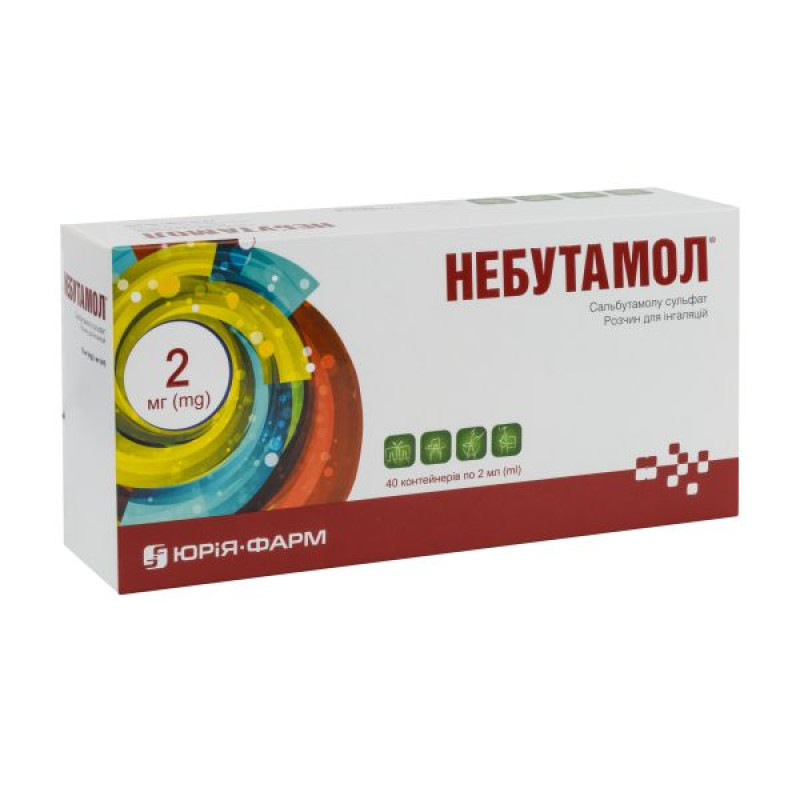
Instructions Nebutamol inhalation solution 1 mg/ml single-dose container 2 ml No. 40
Composition
active ingredient: salbutamol;
1 container contains 2 mg or 2.5 mg of salbutamol sulfate in terms of salbutamol;
1 ml contains: 1 mg of salbutamol sulfate in terms of salbutamol;
Excipients: sodium chloride, water for injections.
Dosage form
Solution for inhalation.
Main physicochemical properties: clear colorless liquid.
Pharmacotherapeutic group
Antiasthmatic drugs. Selective β2-adrenergic agonists. ATC code R03A C02.
Pharmacological properties
Pharmacodynamics
Salbutamol is a selective β2-adrenergic agonist. At therapeutic doses, it acts on the β2-adrenergic receptors of the bronchial muscles with minimal or no effect on the β1-adrenergic receptors of the heart.
Pharmacokinetics
After inhalation, 10% to 20% of the administered dose reaches the lower respiratory tract. The remainder remains in the oropharynx, from where it is swallowed. The portion of the dose that reaches the respiratory tract is absorbed into the lung tissue and enters the bloodstream, but is not metabolized in the lungs.
The onset of action of the drug occurs 4–5 minutes after inhalation, and the duration of action is 4–6 hours.
After entering the systemic circulation, the drug is metabolized in the liver and excreted mainly by the kidneys in an unchanged state and as a phenol sulfate metabolite.
A dose of the drug that has reached the digestive system from the nasopharynx is absorbed from the gastrointestinal tract, undergoes the first stage of metabolism in the liver to a phenol sulfate compound, and is then excreted by the kidneys.
Indication
Treatment of adults and children aged 4 years and over. The drug is indicated for the rapid relief of acute attacks of bronchial asthma, as well as for the treatment of patients with chronic obstructive bronchitis who do not respond to traditional therapy.
Contraindication
History of hypersensitivity to any component of the drug.
Although salbutamol in the form of a solution for intravenous injection and sometimes in the form of tablets and suppositories is used in the management of premature labor, salbutamol in the form of an aerosol for inhalation is not used for these indications. Salbutamol is not used in threatened miscarriage.
Interaction with other medicinal products and other types of interactions
Salbutamol is not prescribed together with non-selective β-blockers such as propranolol.
Salbutamol is not contraindicated for use in patients treated with monoamine oxidase inhibitors.
Application features
Nebutamol should be used by inhalation through the mouth and should not be administered by injection or swallowed.
Treatment of bronchial asthma should be carried out according to a step-by-step program, the patient's condition should be assessed clinically and with the help of functional lung tests.
An increase in the frequency of use of short-acting inhaled β2-agonists indicates worsening asthma control. In this case, the patient's therapy should be reviewed.
Sudden and progressive worsening of asthma is a life-threatening condition that requires initiation or increase in the use of corticosteroids. Daily monitoring of peak expiratory flow is recommended for patients at risk.
Patients who are treated with Nebutamol at home should be warned about the following: if an effective dose of the drug does not bring relief or the duration of this relief decreases, you should consult a doctor and not increase the dose of the drug or the frequency of its use on your own.
Nebutamol should be used with caution in patients receiving large doses of other sympathomimetics.
Sympathomimetics, including salbutamol, have been shown to have effects on the cardiovascular system. Post-marketing and published data suggest that myocardial ischemia has been reported rarely in association with salbutamol. Patients with underlying cardiac disease (e.g., ischemic heart disease, arrhythmia, or severe heart failure) treated with salbutamol should seek medical attention if they develop chest pain or other symptoms suggestive of worsening cardiac disease. Attention should be paid to evaluating symptoms such as dyspnea and chest pain, which may be due to both cardiac and respiratory disease.
Salbutamol should be prescribed with caution to patients with thyrotoxicosis.
Severe hypokalemia may result from treatment with β2-agonists; this is mainly observed with parenteral or nebulized forms. Particular attention is paid to patients with acute severe bronchial asthma, as hypokalemia may be potentiated by concomitant use of xanthine derivatives, steroids, diuretics, and hypoxia. In this situation, it is recommended to check the level of potassium in the blood serum.
As with other inhaled medications, paradoxical bronchospasm with worsening shortness of breath may occur. In this case, alternative dosage forms or other rapid-acting inhaled bronchodilators should be administered immediately. Nebutamol should be discontinued immediately and, if necessary, other rapid-acting bronchodilators should be administered on a permanent basis.
Like other β-adrenergic agonists, Nebutamol can lead to reversible metabolic changes, for example, an increase in blood sugar levels.
Compensation for such changes in diabetic patients is not always possible, therefore there are isolated reports of the development of ketoacidosis in such patients. Concomitant use of corticosteroids may exacerbate this condition.
Very rarely, cases of lactic acidosis have been reported in patients with acute asthma treated with high doses of salbutamol administered intravenously or via nebulizer (see section "Adverse reactions"). An increase in blood lactate levels may cause dyspnea and compensatory hyperventilation, which may be mistaken for insufficient efficacy of anti-asthma treatment and, in turn, lead to inappropriate intensification of treatment with short-acting β2-agonists. Therefore, it is recommended to monitor serum lactate levels in such patients and, accordingly, the presence of metabolic acidosis.
Use during pregnancy or breastfeeding
Salbutamol should be used during pregnancy only if the expected benefit to the mother outweighs the potential risk to the fetus. In post-marketing experience, there have been isolated reports of various congenital anomalies, including cleft palate and limb defects, in children whose mothers used salbutamol during pregnancy. Some of these women also used other medications during pregnancy. A clear causal relationship between the occurrence of these anomalies and the use of salbutamol has not been established.
Since salbutamol can pass into breast milk, its use during breast-feeding is not recommended, except in cases where the expected benefit to the mother outweighs the possible risk to the child. It is not known whether the presence of salbutamol in breast milk has a harmful effect on the child.
Ability to influence reaction speed when driving vehicles or other mechanisms
There is no data on the effect. In case of adverse reactions from the nervous system (tremor), driving or working with other mechanisms should be restricted.
Method of administration and doses
The drug Nebutamol is intended for inhalation use by inhalation through the mouth using a nebulizer, it should be used under the supervision of a physician.
The solution should not be injected or swallowed.
Increased β2-agonist requirements may indicate worsening asthma. In these circumstances, the patient's treatment regimen should be reviewed and the need for concomitant glucocorticosteroid therapy considered.
Adults (including elderly patients)
The usual starting dose of inhaled salbutamol is 2.5 mg. This can be increased to 5 mg. The inhalation can be repeated up to 4 times a day.
For the treatment of adult patients with severe airway obstruction, doses may be increased to 40 mg per day, however, such treatment should be carried out in a hospital setting under close medical supervision.
Children aged 12 and over
Doses are the same as for adults.
Children aged 4 to 11 years
The usual starting dose of inhaled salbutamol is 2.5 mg. This can be increased to 5 mg. The inhalation can be repeated up to 4 times a day.
For children under 4 years of age, other dosage forms of the drug should be used.
The clinical efficacy of nebulized salbutamol in infants under 18 months of age has not been established.
Since transient hypoxemia is possible, the need for supplemental oxygen therapy should be considered.
Nebutamol should normally be used undiluted. However, if inhalations are required for a prolonged period (more than 10 minutes), the contents of the single-dose container may be diluted with sterile saline.
Aerosol inhalation can be carried out using a special face mask or mouthpiece. The room where inhalation is carried out should be periodically ventilated. In case of risk of hypoxia due to hypoventilation of the inhaled air, the air should be enriched with oxygen.
Only a doctor can increase the dosage and frequency of use of the drug, given the possibility of side effects if the dose is exceeded.
Instructions for use of the drug Nebutamol
1. Prepare the nebulizer for use.
3. Shake the single-dose container that was removed. Leave the remaining single-dose containers in the plastic bag and place them in the cardboard box.
4. Holding the single-dose container by the top edge, turn the other edge to open the container.
5. Insert the single-dose container into the nebulizer with the open edge down and press lightly. Make sure that all the medication has flowed into the nebulizer.
6. Assemble the nebulizer and use it according to the instructions for using the nebulizer.
7. After use, rinse the nebulizer and dispose of any remaining medication.
Children
Nebutamol should be prescribed to children aged 4 years and older.
Overdose
The most common symptoms of salbutamol overdose are transient changes pharmacologically induced by β2-agonists, such as tachycardia, tremor, hyperactivity and metabolic disturbances, including hypokalemia (see sections 4.4 and 4.8).
Hypokalaemia may occur as a result of an overdose of salbutamol, therefore serum potassium levels should be monitored. Lactic acidosis has been reported with high therapeutic doses or overdose of short-acting β2-agonists, therefore serum lactate levels should be monitored. Accordingly, metabolic acidosis should be monitored, particularly in cases of persistent or increasing respiratory distress despite improvement in bronchospasm symptoms.
Side effects
The adverse reactions listed below are classified by system organ class and frequency. The frequency of occurrence is classified as follows: very common (≥ 1/10), common (≥ 1/100 and < 1/10), uncommon (≥ 1/1,000 and < 1/100), rare (≥ 1/10,000 and < 1/1,000), very rare (< 1/10,000), including isolated reports. In general, very common and common adverse reactions are determined from clinical trial data, while rare, very rare and unknown adverse reactions are determined from spontaneous reports.
From the immune system.
Very rare: hypersensitivity reactions including angioedema, urticaria, bronchospasm, hypotension and collapse.
From the side of metabolism.
Rare: Hypokalaemia. Potentially severe hypokalaemia may result from treatment with β2-agonists.
Frequency unknown: lactic acidosis (see section "Special warnings and precautions for use").
Neurological disorders.
Common: tremor, headache.
Very rare: hyperactivity.
Cardiac disorders.
Common: tachycardia.
Uncommon: palpitations.
Very rare: cardiac arrhythmias, including ventricular fibrillation, supraventricular tachycardia and extrasystole.
Frequency not known: myocardial ischemia (see section "Special warnings and precautions for use").
Since these reports are spontaneous, their frequency cannot be determined from post-marketing surveillance.
From the side of the vessels.
Rare: peripheral vasodilation.
On the part of the respiratory system, chest organs and mediastinum.
Very rare: paradoxical bronchospasm.
From the gastrointestinal tract.
Uncommon: irritation of the mucous membranes of the mouth and pharynx.
From the side of the musculoskeletal system and connective system.
Uncommon: muscle cramps.
Expiration date
3 years.
After opening the plastic film package – 3 months.
Storage conditions
Store out of the reach of children at a temperature not exceeding 25 °C.
Avoid freezing and exposure to direct sunlight.
Packaging
2 ml or 2.5 ml in single-dose containers. 10 single-dose containers in a plastic film bag, 1 bag or 4 bags in a cardboard box.
Vacation category
According to the recipe.
Producer
LLC "Yuria-Pharm".
Address
Ukraine, 18030, Cherkasy region, Cherkasy city, Kobzarska st., 108. Tel. (044) 281-01-01.
There are no reviews for this product.
There are no reviews for this product, be the first to leave your review.
No questions about this product, be the first and ask your question.







